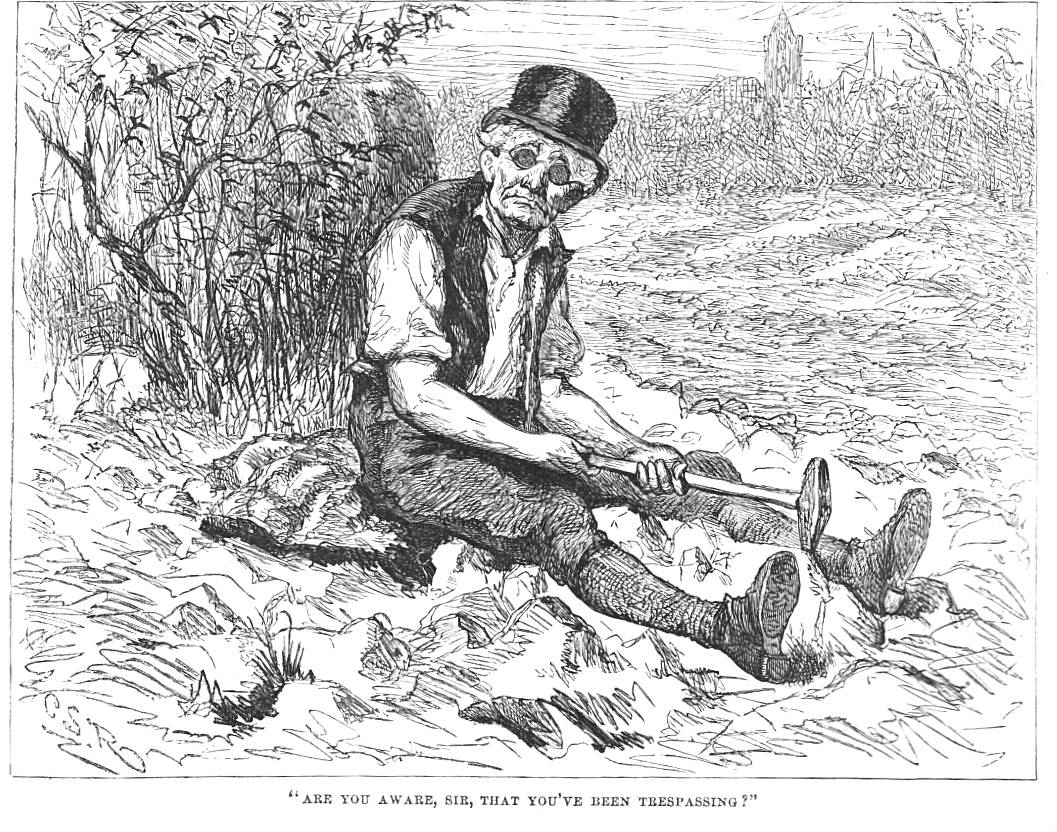
Are you aware, Sir, that you've been trespassing? by Charles S. Reinhart. 1844-1896. 9.9 cm high by 13.1 cm wide (half-page, horizontally mounted, 95). [Click on image to enlarge it.]
The wood-engraving illustrates a scene on page 96 in "An Old Stage-Coaching House," the twenty-second chapter in Charles Dickens's The Uncommercial Traveller, this essay having first appeared in All the Year Round on 1 August 1863. The American Household Edition, also containing Reinhart's wood-engravings for Hard Times (1854) and Fildes' for The Mystery of Edwin Drood (1870), was published by Harper and Brothers in 1876.
Passage Illustrated
I had to scramble through a hedge and down a steep bank, and I nearly came down a-top of a little spare man who sat breaking stones by the roadside.
He stayed his hammer, and said, regarding me mysteriously through his dark goggles of wire:
"Are you aware, sir, that you've been trespassing?"
"I turned out of the way," said I, in explanation, "to look at that odd post-chaise. Do you happen to know anything about it?"
"I know it was many a year upon the road," said he.
"So I supposed. Do you know to whom it belongs?"
The stone-breaker bent his brows and goggles over his heap of stones, as if he were considering whether he should answer the question or not. Then, raising his barred eyes to my features as before, he said:
"To me." [Chapter 22, "An Old Stage-Coaching House," pp. 94-96]
Commentary
In his treatment of this selfsame chapter, Edward G. Dalziel in the British Household Edition has depicted instead an old innkeeper Mr. J. Mellows, again with the intention of dramatising the sudden collapse of the transportation system that had flourished from the late seventeenth century right up to the 1840s, when the advent of railways in south-western England destroyed coaching firms and turnpikes alike. Like Dalziel's listless innkeeper Reinhart's querulous turnpike-keeper lacks both customers and a purpose in life.
As early as 1837, in his final editorial for Bentley's Miscellany, Dickens had forecast the eventual extinction of the country's coaching service, which first developed in the early years of the Restoration. On 18 April 1840 in the third number of Master Humphrey's Clock the ebullient Pickwickian coachman, Tony Weller, had blasted the railway for what it was doing to men of his vocation (as cited in Slater and Drew, p. 269). Certainly the coming of the railways to south-western England spelled the doom of any market town not fortunate to be connected to the country's larger cities by twin ribbons of steel. With the decline of regular coach service, the turnpike roads failed to generate sufficient revenues to maintain some 30,000 miles of highway, became uneconomical to operate, and were "disturnpiked" by Parliament in the 1870s as the supervisory trusts became insolvent, rendering some 8,000 tollbooths relics of a bygone era. No wonder the former turnpike-keeper wears such a glum expression!
Reinhart's once-useful functionary has been reduced to the status of stone-breaker, his smoke-glass googles and sledge-hammer the outward and visible signs of his vocational deterioration. Instead of the highroad, the backdrop is weeds and straggling vegetation; the only reminder of civilisation is a church spire in the distance, obscured by unrestrained natural growth. He, like Mellows in Dalziel's illustration, is a once-respectable character (as suggested by his vest, breeches, and top hat) washed up by the tides of technological and social change.
Scanned image and text by Philip V. Allingham [You may use this image without prior permission for any scholarly or educational purpose as long as you (1) credit the photographer and (2) link your document to this URL in a web document or cite the Victorian Web in a print one.]
Bibliography
Bentley, Nicolas, Michael Slater, and Nina Burgis. The Dickens Index. New York and Oxford: Oxford U. P., 1990.
Dickens, Charles. The Uncommercial Traveller, Hard Times, and The Mystery of Edwin Drood. Il. Charles Stanley Reinhart and Luke Fildes. The Household Edition. New York: Harper and Brothers, 1876.
Dickens, Charles. The Uncommercial Traveller. Il. Edward Dalziel. The Household Edition. London: Chapman and Hall, 1877.
Scenes and Characters from the Works of Charles Dickens; being eight hundred and sixty-six drawings, by Fred Barnard, Hablot Knight Browne (Phiz); J. Mahoney; Charles Green; A. B. Frost; Gordon Thomson; J. McL. Ralston; H. French; E. G. Dalziel; F. A. Fraser, and Sir Luke Fildes; printed from the original woodblocks engraved for "The Household Edition." New York: Chapman and Hall, 1908. Copy in the Robarts Library, University of Toronto.
Slater, Michael, and John Drew, eds. Dickens' Journalism: 'The Uncommercial Traveller' and Other Papers 1859-70. The Dent Uniform Edition of Dickens' Journalism, vol. 4. London: J. M. Dent, 2000.
Created 10 April 2013
Last modified 6 January 2020